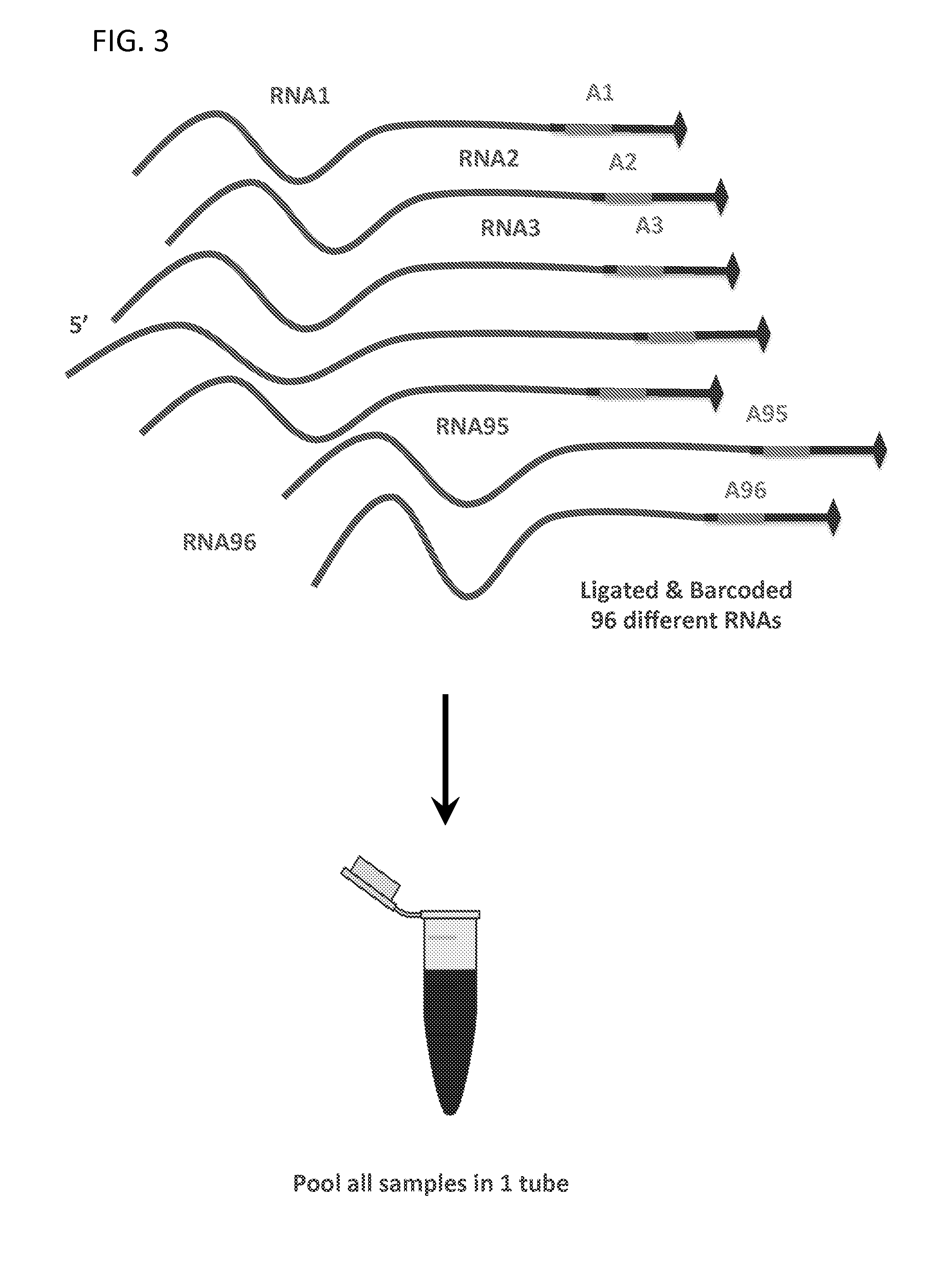Massively Multiplexed RNA Sequencing
a rna sequencing and multiplexing technology, applied in the field of rna sequencing, can solve the problems of cumbersome and expensive sequencing of specific strands of rna, and achieve the effect of low cost and low tim
- Summary
- Abstract
- Description
- Claims
- Application Information
AI Technical Summary
Benefits of technology
Problems solved by technology
Method used
Image
Examples
example 1
[0079]The following protocol is used as a non-limiting example of the methods disclosed herein. While specific times and reagents are specified, it is contemplated that different, albeit similar reagents, times, and temperatures can be employed by those of ordinary skill in the art with minimal experimentation, given the guidance presented herein.
[0080]Multiplexing version: The first 9 nucleotides of the first read will contain a barcode (reverse & complement), where the 9th nucleotide will always be the same for each barcode (A / T).
[0081]Each sample in the single pool has the same molarity. A Bravo robot or 96-well pipettor could be used for 48-96 samples.
[0082]Use selected RNA or upto 250 ng of total RNA / sample.
[0083]Fragment and dephosphorylate RNA samples with FastAP and PNK.
[0084]Step A. First Ligation (RNA / RNA or RNA / DNA) 3′ Linker Ligation
[0085]Mix RNA+adapter+DMSO. Heat at 70° C. for 2 min→put on ice
[0086]Perform reaction as follows:
Ligation Mix1 tubeN tubesDephosphorylated R...
example 2
RNA Depletion Protocol
[0125]Step A. Oligo-based rRNA depletion after RNA+adapter ligation.
Make your anti-sense RNA probes using both bio-UTP and bio-CTP (1:5 ratio for each=bio-UTP / UTP and bio-CTP / CTP).
Probe generation mix: Total=50 μl: H2O=22.4 μl, NEB T7 buffer=5 μl
DNA=500-1000ng=10 μl
100 mM ATP=1 μl, 100 mM GTP=1 μl, 100 mM CTP=0.8 μl
[0126]100 mM UTP=0.8 μl, 10 mM bio-UTP=2 μl, 10 mM bio-CTP=2 μl
RNAse inhibitor=1 μl, T7 enzyme mi×=4 μl
Incubate 2-15 hours at 37 C. Add TurboDNAse, FastAP, clean with high-capacity
RNA columns, like RNEasy (Qiagen).
[0127]Step B. Oligo-based rRNA depletion Hybridization. Use 10×rRNA probes mix (18s+28s+5.8s+5s+other regulatory RNAs=1×+2.35×+0.25×+0.2×+0.2×) with your sample (500 ng of rRNA probe mix for 50 ng of input):
#ratioμgμlconcm18s1.212200.6m28s12.929660.4428sL0.3360.55.8s0.3380.365s0.223.30.645s0.3137.20.43rRNA spacers0.3137.40.42U3B0.212.14.50.47U1B0.111.70.59U3A0.112.20.45U20.112.30.44U50.050.520.24H2O = 17360.7130.6200 ng / μL
[0128]Hybridize in...
PUM
| Property | Measurement | Unit |
|---|---|---|
| nucleic acid | aaaaa | aaaaa |
| nucleic acid sequence | aaaaa | aaaaa |
| length | aaaaa | aaaaa |
Abstract
Description
Claims
Application Information
 Login to View More
Login to View More - R&D
- Intellectual Property
- Life Sciences
- Materials
- Tech Scout
- Unparalleled Data Quality
- Higher Quality Content
- 60% Fewer Hallucinations
Browse by: Latest US Patents, China's latest patents, Technical Efficacy Thesaurus, Application Domain, Technology Topic, Popular Technical Reports.
© 2025 PatSnap. All rights reserved.Legal|Privacy policy|Modern Slavery Act Transparency Statement|Sitemap|About US| Contact US: help@patsnap.com



